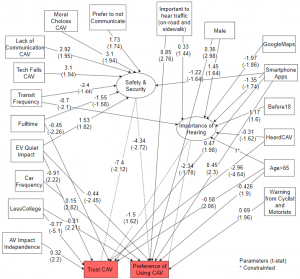Sina Azizi Soldouz, MASc thesis, Civil Engineering, 2019
Professor Khandker Nurul Habib, Supervisor
Summary
Simply stated, a fully autonomous transportation system allows vehicles to communicate with each other and prominently to the world around them. There is no question that municipal streets will function very differently once connected autonomous vehicles (CAV) technology is commonplace. When this happens, interactions between vulnerable groups such as persons with sight loss or total blindness will also be transformed.
This project identifies the impacts and accessibility barriers posed by CAV technology for pedestrians with sight loss and discusses ways in which these barriers might be overcome. A comprehensive survey of Canadians and non-Canadians with sight loss was conducted by collaborating with the Canadian National Institute for the Blind (CNIB). Overall, this project seeks to provide evidence-based recommendations regarding the creation of barriers as CAV technologies are introduced.
To better understand the dataset, a factor analysis method and a structural equation modeling (SEM) approach were used to determine the relevant latent factors as well as significant parameters on our dependent variables.

- As we can observed from the SEM results, people who prefer to have some sort of communications and get auditory feedback from CAV when they want to cross the roads are more likely to be sensitive about “safety & security” as well as “the importance of hearing” latent factors.
- Interestingly, we found that people who have been using a combination of technologies and applications for navigating on a daily basis are more likely to use CAV, trust these vehicles, and communicate with them.
- When considering the noise reduction issue of CAV. People who have an experience to be near an accident with an electric vehicle seem to be more sensitive to get audible alerts from cyclists and motorists both on roads and sidewalks and have more negative views on CAV because it would be too silent same as electric vehicles.
- In terms of policy recommendation, it was found that implication of different technologies to be used in the orientation & mobility (O&M) programs could have a significant effect on their levels of knowledge and acceptance about new technologies and accordingly their opinions about using them for improving their independence and mobility.
- It was found that a combination of applications on smart devices (more common smartphones) and tools that could be connected to the current infrastructure (such as accessible pedestrian signal system) with the small need of modifications would be another policy recommendation that seems to be more beneficial than afterthought solution when CAV become available in large scale.
Abstract
This thesis develops a policy-framework that can be used for minimizing communication issues between connected autonomous vehicles (CAVs) and visually impaired pedestrians. The existing literature on CAVs is highly focused on different perspectives of the possible users of these technologies. Since, this research uses a dataset collected through a tailor-made stated adaptation survey among visually impaired pedestrians. The dataset includes the current mobility issues of this community, their perceptions about CAVs, and a wide range of socioeconomic attributes. Some evidence-based recommendations are provided on communication techniques, based on the key findings of a series of structural equation models (SEM) and ordered logit models estimated using the survey data. The results reveal that the low-noise issue of electric engines influences visually impaired pedestrians’ safety and security in the contexts of CAVs. It shows that respondents who rely on mobile applications and technology-based devices for navigating purposes tend to trust in CAVs.
Supervisor contact information
Professor Khandker Nurul Habib
Tel.: 416-946-8027
khandker.nurulhabib@utoronto.ca
